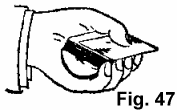THE bottom palm may be held while the deal is in progress without inconvenience. The ruse is adopted for one of several reasons. It may be to avoid the risk of replacing the palm immediately after the cut; as a more favorable opportunity occurs just after the deal when the remainder of the deck is placed on the table. This would be of service in games such as Poker or Casino. The bottom cards can be obtained on the second deal. Sometimes the palm is made after the cut and maintained throughout the deal for the purpose of holding too many. The dealer’s cards are placed on the palmed cards, the whole "skinned" through, the discard palmed again in one or the other hand, and replaced when the deck is taken up again. If the bottom palm is made before the cut and maintained throughout the deal it both gives too many and avoids the necessity of bottom dealing, but it is a very poor substitute. This is fully explained under caption of "Skinning the Hand."

The cards are palmed in the left hand and the deck; placed across them. The deal is begun immediately. The four fingers of the left hand are kept close together with the tips held firmly against the side of deck, and effectually conceal the palmed cards. (See Fig. 47.) There is little or no difficulty in performing this perfectly, and the deal can be carried on without a sign to indicate the manoeuvre. The palmed cards will be crimped from their position and the warmth of the hand. The crimp must be taken out when squaring up.
